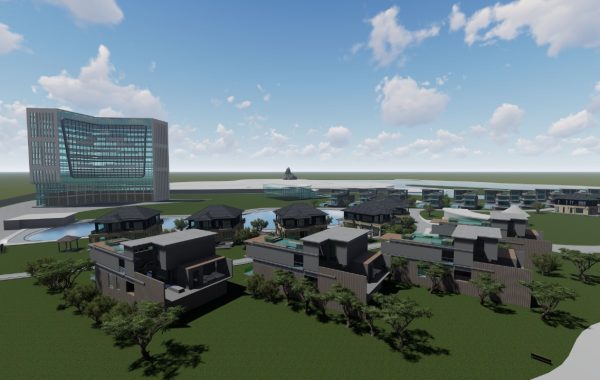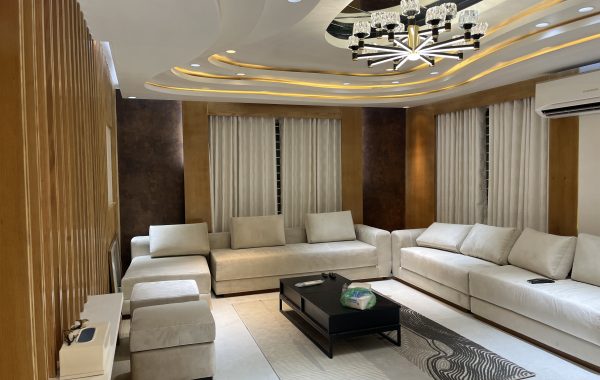
The Role of Office Interior Design in Increasing Productivity
For decades, the standard office was a sea of gray cubicles under harsh fluorescent lights. It was an interior design born from function, but it largely ignored the human element. Today, forward-thinking companies understand that a workplace is more than just a place to work. The physical environment, a key focus of office interior design in Bangladesh, has a profound and measurable impact on office productivity, creativity, and overall employee satisfaction.
A thoughtfully planned office interior design in Dhaka acts as a silent partner in your business’s success. It moves beyond mere aesthetics to create a space that actively supports the tasks at hand, minimizes distractions, and promotes a positive culture. By investing in your workspace, you are investing directly in your most valuable asset: your people. This guide explores how a beautiful and organized office can elevate performance.
Beyond Aesthetics: The Science of a Productive Workspace
It’s easy to dismiss Office Interior Design as simply making a space look good. However, a growing body of research in environmental psychology shows a direct link between our surroundings and our cognitive functions. The layout, lighting, colors, and even the textures within an office, all championed by the best interior design company in Dhaka, can either hinder or enhance an employee’s ability to concentrate, collaborate, and innovate.
A well-designed workplace environment, as delivered by a professional interior design company in Dhaka, is built on a foundation of intentional choices. It considers the natural flow of movement, the types of work being performed, and the psychological needs of the people using the space. When employees feel comfortable, supported, and energized by their surroundings, their motivation and output naturally increase, leading to a tangible return on the design investment. This proves that good design can also be a budget-friendly Office Interior Design by improving output.
This strategic approach transforms the office from a mere cost center into a tool for growth. It acknowledges that a cluttered, poorly lit, or uninspiring space can lead to stress, fatigue, and a decline in performance. Conversely, a space designed with human needs in mind fosters a sense of value and boosts morale, which are crucial for long-term success.
The Foundational Impact of Layout and Space Planning
The physical layout of an office is the skeleton upon which productivity is built. The debate between open-plan offices and traditional cubicles often misses the point; the best solution is rarely one-size-fits-all. A firm like In Art Studio, for example, understands that the ideal layout supports various work styles and provides a balance between private, focused work and dynamic, collaborative efforts. This balanced approach is a core tenet of modern Office Interior Design, whether you’re hiring an interior design company in Paltan or a large corporate firm.
Effective space planning creates intuitive pathways and clear “zones” for different activities. For instance, high-traffic, collaborative areas should be situated away from zones designated for deep concentration. This simple separation drastically reduces unwanted interruptions and noise pollution, allowing employees to fully immerse themselves in their tasks without constant distractions, thereby enhancing office productivity.
This zoning strategy also improves workflow efficiency. When teams that frequently collaborate are located near each other, and common resources like printers or meeting rooms are centrally accessible, time wasted moving around the office is minimized. A logical and fluid layout, the hallmark of the best Office Interior Design company in Bangladesh, means less friction in daily operations and more time dedicated to meaningful work.
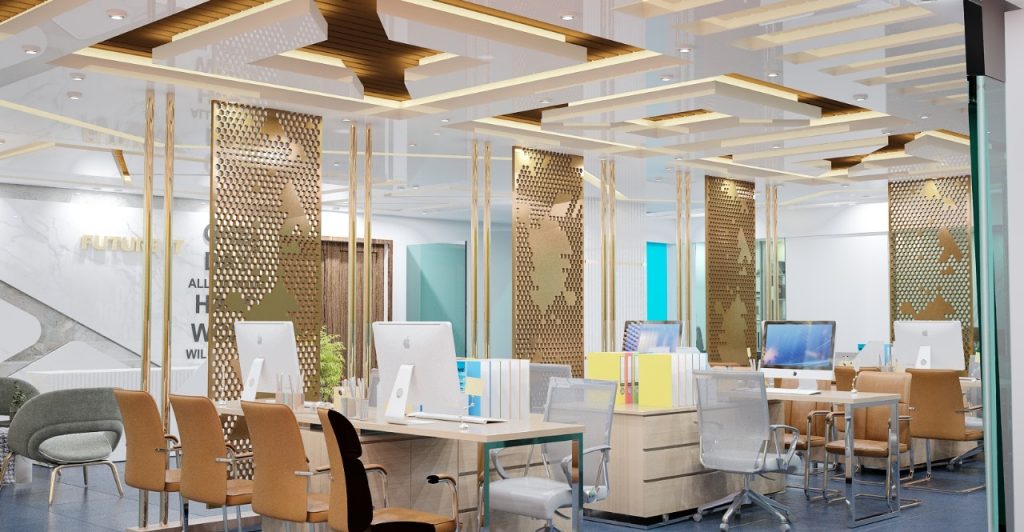

Fostering Collaboration Through Intelligent Design
While individual focus is critical, teamwork and collaboration are the engines of innovation. A successful office interior design actively encourages spontaneous interactions and planned brainstorming sessions. This means creating spaces that draw people together naturally and provide them with the tools they need to share ideas effectively.
Think beyond the traditional conference room. Modern offices incorporate a variety of collaborative spaces, from casual lounge areas with comfortable seating and whiteboards to semi-private booths for small group discussions. These areas signal that teamwork is valued and provide a welcome alternative to huddling around a cramped desk, creating a better workplace environment. This is a solution that the best interior design company near me would definitely recommend for a modern business.
The right furniture also plays a key role. Modular sofas, movable tables, and lightweight chairs allow teams to reconfigure a space to suit their specific needs at a moment’s notice. This flexibility empowers employees to create their own collaborative environments, leading to more organic and productive teamwork that directly contributes to overall company goals.
Harnessing the Power of Light and Color
Lighting is one of the most powerful yet often overlooked elements in office interior design. Poor lighting can cause eye strain, headaches, and drowsiness, all of which are significant drains on office productivity. Maximizing natural light should be the number one priority, as exposure to daylight helps regulate our circadian rhythms, improving mood and energy levels.
To enhance natural light, design choices should include large windows, glass partitions instead of solid walls, and light-colored surfaces that reflect light throughout the space. This holistic view, often connecting the interior with the Best Exterior Design in Dhaka, is crucial. For areas that lack natural light, it’s crucial to implement a layered lighting strategy. This includes ambient overhead lighting combined with task lighting, like desk lamps, to give employees control over their immediate environment.
Color psychology also has a profound impact on our mood and cognitive performance. While stark white walls can feel sterile, strategic use of color can energize or calm a space. Blues and greens are known to promote focus and a sense of well-being, making them ideal for concentration zones. Meanwhile, warmer colors like yellow and orange can stimulate creativity and are excellent for collaborative areas.
Biophilic Design: Connecting with Nature for Better Well-being
Biophilic design is a concept rooted in the idea that humans have an innate need to connect with nature. Incorporating natural elements into the office is a powerful way to reduce stress, improve air quality, and boost creativity. This goes far beyond placing a few potted plants on a windowsill; it’s a holistic interior design philosophy. This philosophy often links the interior design with the Best Exterior Design in Bangladesh, creating a unified, green-focused building.
Implementing biophilic design can be as simple as using natural materials like wood and stone for furniture and finishes. Other powerful applications include creating “living walls” of plants, installing indoor water features for soothing ambient sound, and ensuring that employees have a clear view of the outdoors from their workstations. These elements contribute greatly to employee well-being.
The benefits are scientifically proven. Studies have shown that a connection to nature in the workplace environment can lead to a 15% increase in creativity and a significant reduction in absenteeism. By bringing the outside in, you create a healthier, happier, and more inspiring atmosphere that naturally enhances office productivity.
Modern Office Design Ideas for Peak Performance
The modern office is no longer a static place but an ecosystem designed for flexibility and choice. The most effective modern office interior design trends are centered on the concept of activity-based working (ABW), where employees can choose from a variety of settings that best suit the task they are performing at any given moment.
This approach acknowledges that a person might need a quiet pod for two hours of focused writing, a collaborative lounge for a team brainstorm, and a casual cafe-style area for answering emails. Providing this variety empowers employees, giving them autonomy over their workday and environment. This sense of control is a powerful motivator and productivity booster.
Let’s explore some specific ideas that embody this flexible and human-centric approach. These trends are not just about aesthetics; they are strategic solutions designed to address the diverse needs of today’s workforce, ultimately leading to a more engaged and efficient team.
Embracing Agile and Flexible Workspaces
Agility is key in the modern business world, and the office space should reflect that. Agile workspaces are non-traditional environments that can be easily reconfigured. This includes features like hot-desking (where no one has an assigned desk), movable partitions, and furniture on wheels. This allows teams to expand, contract, or re-form without being constrained by a rigid physical structure.
This level of flexibility supports a dynamic workflow and can be particularly beneficial for project-based teams. It allows them to create a “home base” for the duration of a project and then disband, freeing up the space for others. This adaptability ensures that the office layout is always optimized for the current needs of the business, maximizing space utilization and fostering a culture of change.
Ultimately, an agile design promotes a sense of ownership and responsibility among employees. It trusts them to choose where and how they work best, which can lead to a significant uplift in engagement and office productivity. It’s a shift from designing for roles to designing for activities.
The Necessity of Quiet Zones and Focus Pods
One of the biggest complaints about open-plan offices is the lack of privacy and the constant distractions. While collaboration is important, deep, concentrated work is equally vital. Modern office interior design addresses this by incorporating dedicated quiet zones and individual focus pods.
These spaces are acoustically insulated to block out the buzz of the main office floor. They can range from entire library-style “no talking” rooms to small, single-person pods equipped with a desk, a comfortable chair, and power outlets. They provide a sanctuary for employees who need to write a detailed report, analyze complex data, or simply think without interruption.
By providing these havens for concentration, companies acknowledge the importance of different work modes. This not only boosts the productivity of individuals but also improves the overall workplace environment by reducing the need for people to wear headphones constantly or feel frustrated by noise. It shows a commitment to supporting every aspect of an employee’s job.
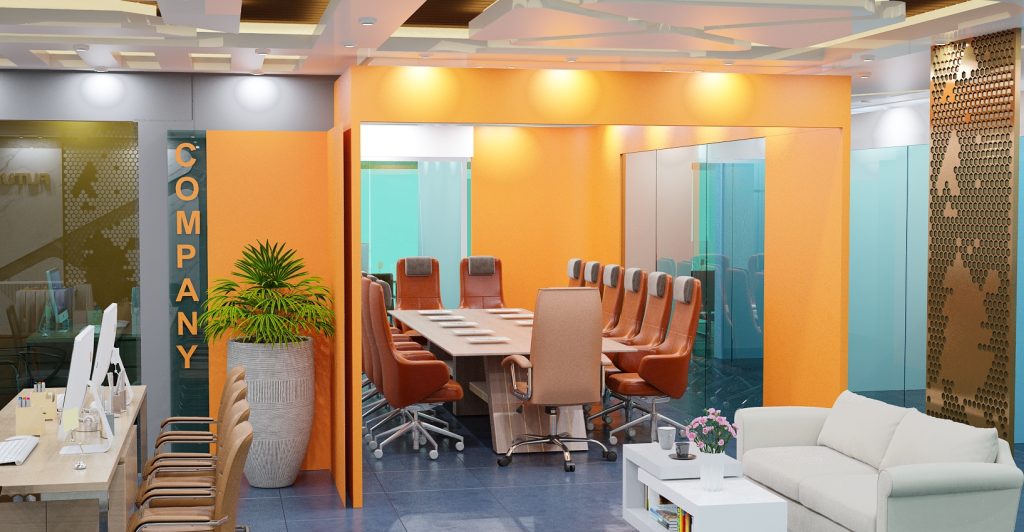
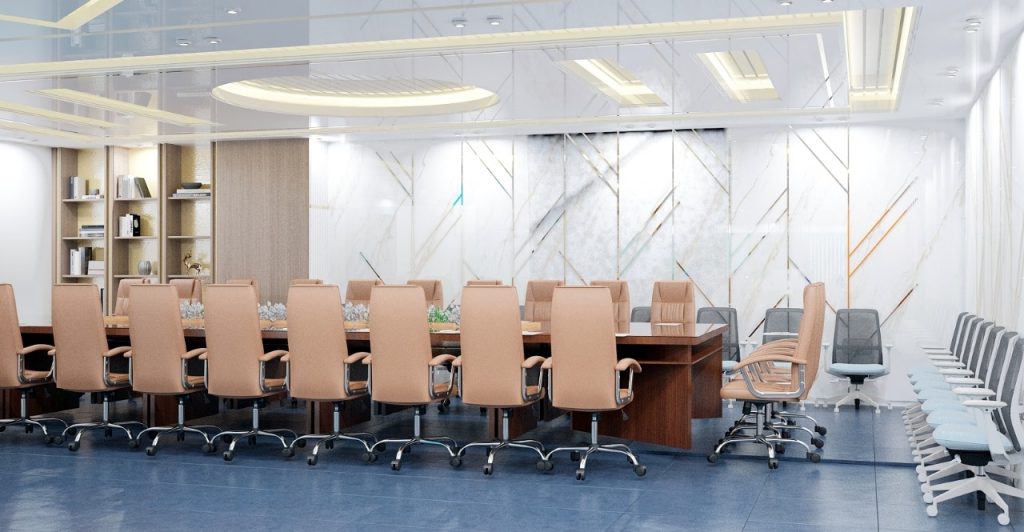
Summary
The design of an office is an influential force that shapes company culture, employee well-being, and overall performance. Moving away from outdated, one-size-fits-all models, a strategic office interior design, often delivered by the best interior design company in Bangladesh, creates a multi-faceted environment that supports both individual focus and collaborative innovation. By carefully considering the layout, maximizing natural light, using color psychology, incorporating biophilic elements, and embracing flexible interior design concepts, companies can build a workspace that actively enhances office productivity. An investment in a human-centric workplace is an investment in a more focused, creative, and successful team.
Frequently Asked Questions (FAQ)
Q: How does office layout affect employee productivity?
A: A well-planned layout reduces distractions, improves workflow, and creates dedicated zones for different types of work. It provides a balance between collaborative areas and quiet spaces for concentration, minimizing wasted time and boosting focus.
Q: What is biophilic design, and why is it important for offices?
A: Biophilic interior design involves incorporating natural elements like plants, natural light, and materials like wood and stone into a built environment. It’s important because it’s proven to reduce stress, improve air quality, boost creativity, and enhance overall employee well-being.
Q: Can changing the office lighting really improve productivity?
A: Absolutely. Maximizing natural light and using a layered artificial lighting system can reduce eye strain, prevent headaches, and improve mood and energy levels. Proper lighting is a critical component of a productive workplace.
Q: What is an agile workspace?
A: An agile workspace is a flexible and adaptable office environment that allows employees to choose from a variety of settings based on their tasks. It often includes features like movable furniture, hot-desking, and modular walls to support a dynamic workflow.
Q: Is an open-plan office good or bad for productivity?
A: An exclusively open-plan office can be detrimental to productivity due to noise and distractions. The most effective modern designs use a hybrid model, combining open collaborative areas with enclosed quiet rooms and private pods to support all work styles.


